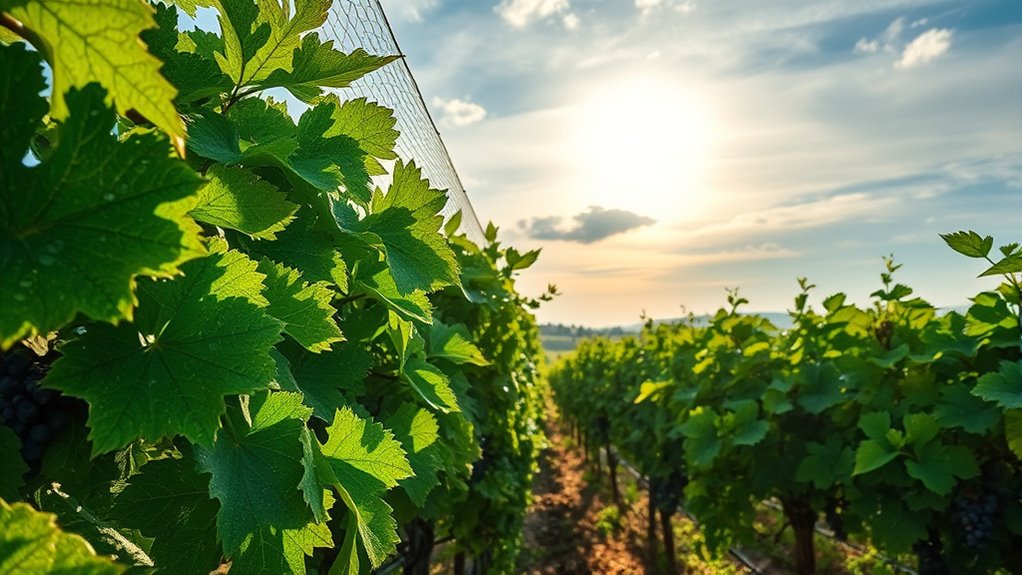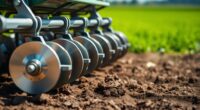To protect your vineyard from downy mildew in late summer, monitor weather conditions closely and inspect vines regularly for early signs like yellow or white patches. Enhance airflow by pruning and removing debris, and adjust watering to reduce leaf moisture. Use effective fungicides promptly—rotating modes of action to prevent resistance—and apply them thoroughly, especially on the undersides of leaves. Combining these practices with vigilant observation will help keep your vineyard healthy; learn more to deepen your strategy.
Key Takeaways
- Monitor weather conditions and vineyard moisture to anticipate downy mildew infection periods.
- Implement canopy management by pruning and spacing to improve airflow and reduce humidity.
- Apply targeted fungicides proactively before infection periods, rotating modes of action for resistance management.
- Remove and destroy infected plant material promptly to prevent disease spread.
- Conduct regular vineyard inspections for early symptom detection, enabling timely intervention.
Understanding the Lifecycle of Downy Mildew

Understanding the lifecycle of downy mildew is essential for effective vineyard protection. You need to recognize that it begins with spores called oospores, which overwinter in grapevine tissue or soil. When conditions become moist and warm, these spores release new spores called sporangia. These sporangia spread through the air and infect new plant tissues, especially young leaves and shoots. As the fungus develops, you’ll see yellowish, oily spots on the leaf surfaces. The disease progresses quickly under favorable weather, with spores producing new spores in a cycle that can repeat multiple times in a season. Recognizing disease development stages can help growers implement targeted interventions promptly. By understanding this lifecycle, you can better anticipate infection periods and implement timely controls to minimize damage and protect your vineyard’s health.
Monitoring Weather Conditions and Vine Health
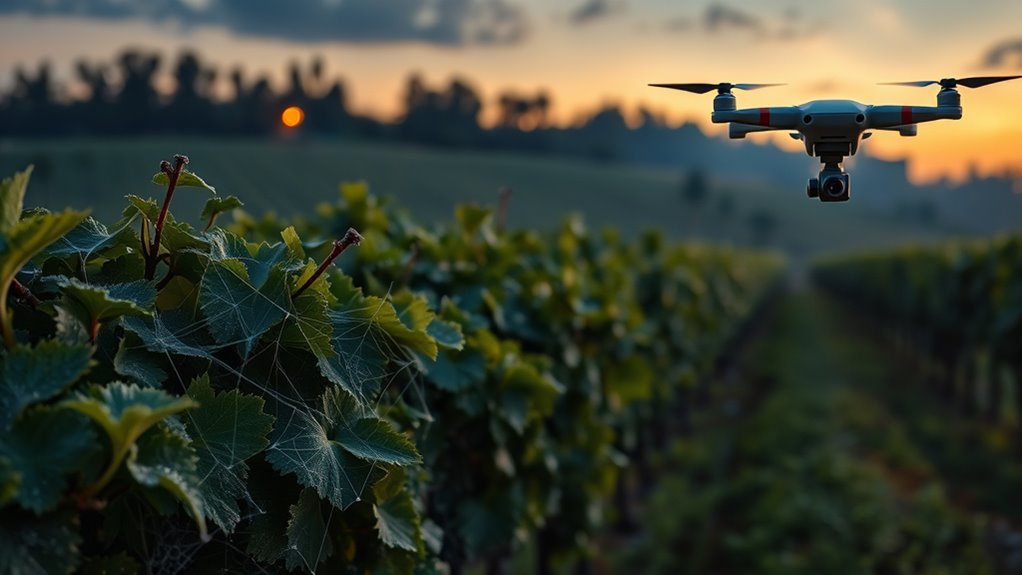
Keeping an eye on weather patterns helps you predict when conditions favor downy mildew development. Regularly assess your vines for signs of stress or disease to catch problems early. By combining weather tracking with vine health checks, you can better time your protective measures. Additionally, understanding the growth stages of your vineyard can help determine the most effective times for intervention.
Weather Pattern Tracking
Have you noticed how weather patterns directly influence the risk of downy mildew in your vineyard? Tracking these patterns helps you anticipate outbreaks and take timely action. Pay close attention to rainfall, humidity, and temperature fluctuations, especially during late summer when conditions often favor the disease. Use weather stations or apps to monitor daily changes and identify prolonged periods of wetness or high humidity, which create ideal conditions for downy mildew spores to thrive. Recognizing these patterns early allows you to adjust your vineyard management strategies proactively. Maintaining consistent records of weather conditions helps you predict future risks more accurately. Monitoring headphone connectivity or audio settings can also help ensure proper communication during vineyard management tasks. By staying vigilant and informed, you can implement targeted treatments, reducing the impact of downy mildew and safeguarding your grapevines effectively.
Vine Condition Assessment
Monitoring both weather conditions and vine health is essential for early detection of downy mildew risks. Regularly inspect your vines for early signs like yellowing leaves, fuzzy growths, or lesions, especially in humid or wet conditions. Keep track of weather patterns, noting periods of rain, high humidity, or dew formation, which create ideal environments for the pathogen. Use a magnifying glass or hand lens to examine the undersides of leaves closely. Record your observations consistently to identify patterns and potential trouble spots. Combining weather data with visual assessments helps you anticipate outbreaks before they spread. Staying vigilant allows you to implement targeted treatments promptly, minimizing damage and protecting your crop effectively. Understanding fungal biology can further improve your management strategies by providing insights into how the pathogen interacts with environmental factors.
Selecting Effective Fungicides and Application Timing

Choosing the right fungicides and applying them at the right time is essential for effective downy mildew control. You need to select products proven to work against the disease and time your applications to match weather conditions and vine development stages. This approach helps ensure thorough coverage and reduces the likelihood of resistance buildup. Additionally, selecting appropriate equipment can enhance application efficiency and coverage, leading to better protection for your vineyard.
Optimal Fungicide Choices
Selecting the right fungicide and applying it at the critical time are essential steps in effectively managing downy mildew in your vineyard. Choose fungicides with proven effectiveness against downy mildew, such as copper-based products, phosphonates, or specific fungicides like mefenoxam. Always read labels to guarantee proper coverage and resistance management. Rotate fungicides with different modes of action to prevent resistance development. Apply fungicides when conditions favor disease development, such as high humidity or leaf wetness. Use a spray volume that thoroughly coats the foliage, paying special attention to the undersides of leaves where the pathogen often resides. Proper fungicide choice combined with precise application ensures better protection and reduces the risk of disease outbreaks later in the season. Incorporating crochet tools can enhance understanding of protective strategies through creative visualizations and demonstrations.
Timing for Maximum Effect
Timing your fungicide applications to coincide with conditions that favor downy mildew development is essential for maximizing their effectiveness. You should monitor weather patterns closely—particularly leaf wetness, humidity, and temperature—since these factors influence disease spread. Apply fungicides just before or during periods of high humidity and leaf wetness, typically in the early mornings or late afternoons. Regular scouting helps identify infection sites, allowing you to target treatments precisely when they’re most needed. Avoid unnecessary applications during dry, warm spells, which reduce the likelihood of infection. Proper timing guarantees you use fungicides efficiently, reducing costs and environmental impact while providing the best protection for your vineyard. Staying vigilant and responsive to weather changes is key to controlling downy mildew effectively. Additionally, understanding the energetic alignment of your vineyard environment can support healthier plant growth and disease resistance.
Implementing Cultural Practices to Reduce Risk

Implementing cultural practices is essential for reducing the risk of downy mildew in your vineyard. By managing your vineyard environment, you can minimize conditions that favor the disease’s development. Focus on practices such as pruning to improve airflow, which discourages moisture buildup. Remove fallen leaves and debris to eliminate sources of infection. Adjust irrigation to prevent excess moisture on the vine surface, ensuring water doesn’t linger on leaves and clusters. These steps help create a drier, less hospitable environment for downy mildew. Visualize your vineyard with well-spaced vines, clean ground cover, and controlled watering schedules. These practices not only reduce disease pressure but also promote healthier vines, leading to better grape quality and yield. Implementing these cultural measures is a key part of an integrated disease management plan.
Managing Vineyard Canopy for Better Air Circulation
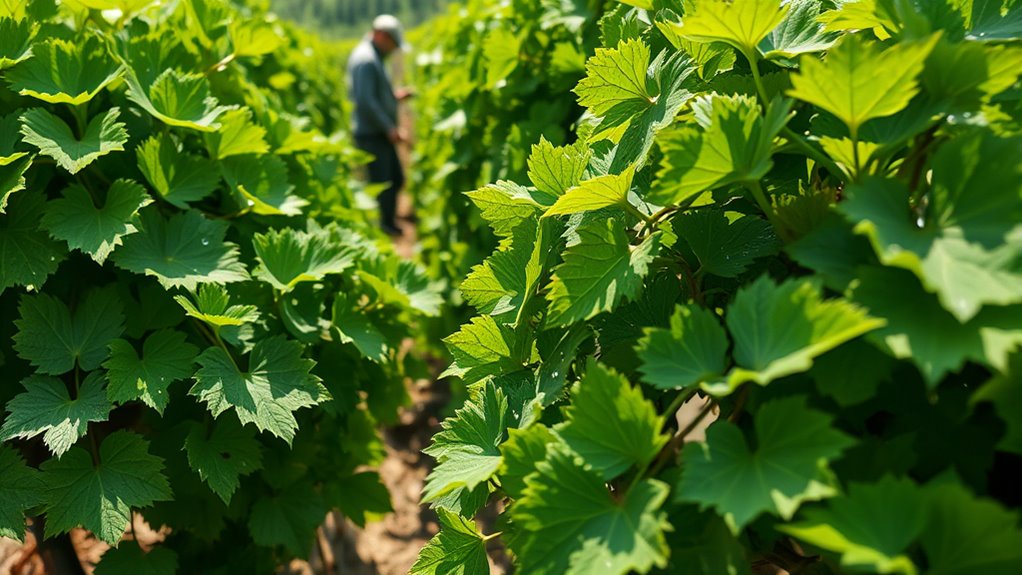
Effective vineyard canopy management is essential for promoting better air circulation, which helps reduce the risk of downy mildew. To achieve this, you should regularly prune excess foliage to open up the canopy, allowing air to flow freely between the vines. Thin dense areas where airflow is obstructed and remove unnecessary shoots or leaves, especially around clusters. Position trellising wires to support even canopy distribution, preventing overcrowding. Keep vine spacing appropriate for your variety and site to encourage airflow. Additionally, consider leaf removal around grape clusters to improve ventilation and sunlight exposure. Incorporating wall organization systems can also help in maintaining tools and equipment for efficient vineyard management. Consistent canopy management not only reduces humidity levels around the grapes but also discourages the development of downy mildew, creating a healthier environment for your vineyard during late summer.
Recognizing Early Symptoms and Responding Quickly

Early detection of downy mildew hinges on your ability to identify its initial signs before the infection spreads. You should regularly inspect your vines, especially during humid late summer weather. Look for distinctive yellow or pale green spots on the upper leaf surfaces, which quickly turn brown. On the undersides, you’ll notice white, downy growth—this is a key early symptom. Stunted or deformed shoots and clusters may also appear if the infection is advanced. Understanding the mechanics of pinball machines can help you recognize how complex systems can be managed to prevent failures; similarly, managing vineyard health requires attention to detail. To respond quickly, remove and destroy infected leaves and shoots to limit spread. Guarantee good air circulation around the vines and apply preventive fungicides if necessary. Prompt action can save your vineyard from severe damage and preserve grape quality.
Developing an Integrated Disease Management Plan
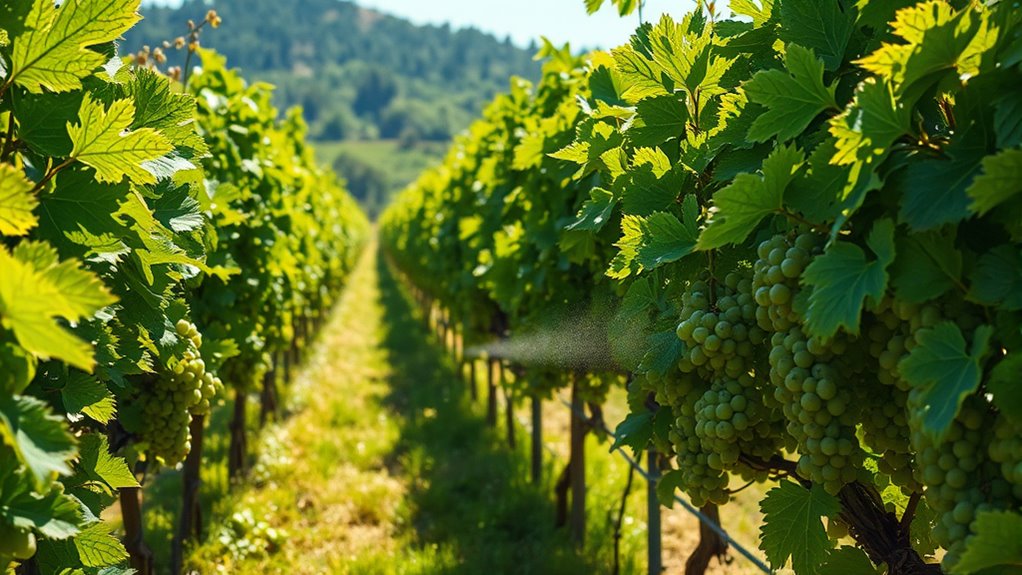
Creating an all-encompassing disease management plan is essential for protecting your vineyard from downy mildew. Start by monitoring weather conditions regularly, especially humidity and leaf wetness, to anticipate infection periods. Incorporate a combination of cultural practices, such as canopy management to improve airflow and reduce humidity, along with targeted fungicide applications. Timing is critical; apply protectant fungicides before infection periods and consider biological controls if available. Keep detailed records of treatments, weather patterns, and disease progression to refine your strategy over time. Educate yourself on resistant grape varieties and integrate these into your vineyard planning. An effective plan balances prevention, early detection, and treatment, reducing disease pressure and minimizing chemical use while maintaining healthy, productive vines.
Frequently Asked Questions
How Long Does Downy Mildew Spores Typically Survive in Vineyard Debris?
Downy mildew spores typically survive in vineyard debris for about 2 to 3 weeks, especially if conditions are moist and cool. To reduce the risk, you should regularly remove or till vineyard debris, as this disrupts the spores’ habitat. Proper sanitation and timely vineyard cleanup are essential for minimizing the spores’ lifespan and preventing future outbreaks, helping you keep your vines healthy throughout the season.
Are There Resistant Grapevine Varieties for Downy Mildew?
Yes, you can choose resistant grapevine varieties to help combat downy mildew. Some cultivars, like certain hybrid grapes, have been bred for increased resistance, reducing your need for chemical treatments. When selecting varieties, look for those specifically labeled as resistant or tolerant. Keep in mind that no variety is completely immune, so combining resistant grapes with good vineyard practices gives you the best protection against downy mildew.
Can Organic Methods Effectively Control Downy Mildew in Late Summer?
Think of organic methods as your first line of defense in a battle against downy mildew. Yes, they can be effective if you stay vigilant. You should apply copper-based fungicides and sulfur, ensuring good canopy airflow and removing infected leaves promptly. Regular scouting is essential to catch early signs, allowing you to act quickly. With consistent effort, organic methods can keep the mildew at bay and protect your vineyard’s health.
What Are the Economic Impacts of Downy Mildew Outbreaks?
Downy mildew outbreaks can hit your vineyard’s profits hard, leading to reduced yields and lower grape quality. You might face increased costs for fungicides and labor, which cut into your margins. If you don’t manage outbreaks promptly, you could lose entire crops, causing significant financial setbacks. Additionally, the reputation of your vineyard might suffer, affecting future sales and long-term profitability. Staying vigilant helps protect both your crop and your bottom line.
How Does Downy Mildew Affect Grape Quality and Wine Production?
Downy mildew markedly harms grape quality and wine production by causing moldy, shriveled grapes that reduce yields and alter flavor profiles. You might notice affected berries with fuzzy growth and discoloration, leading to inconsistent wine characteristics. This disease weakens grape skins, increasing spoilage risk and fermentation problems. As a result, you face higher production costs, potential loss of premium qualities, and compromised wine clarity, aroma, and overall taste, ultimately impacting your vineyard’s reputation and profitability.
Conclusion
By blending vigilant monitoring with strategic sanitation and swift spraying, you can markedly diminish downy mildew’s dominance. Cultivate clean canopies, carefully calibrate your chemicals, and consistently check for cues of infection. With a proactive approach, you’ll protect your precious vineyard, preventing problems before they proliferate. Remember, a vigilant and vigilant vineyard is a victorious vineyard—so stay attentive, act promptly, and enjoy a healthy, harvest-ready vineyard come late summer.

